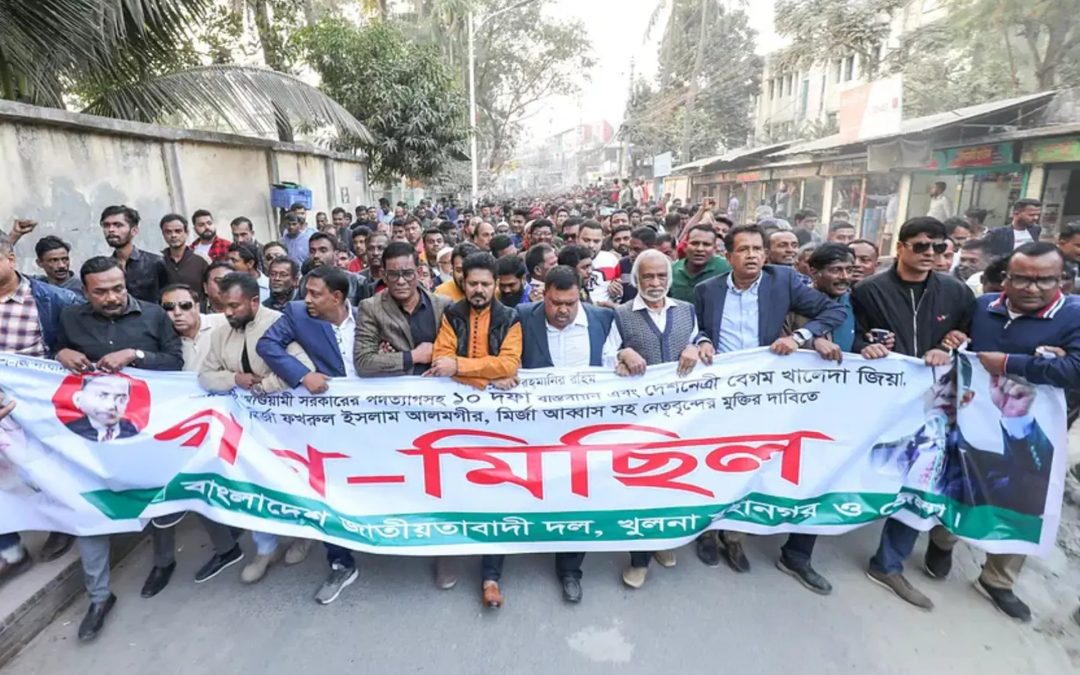On December 24, BNP organized a nationwide demonstration. On December 30, the party will host this function in Dhaka. | Photo: Prothom Alo
A BNP parade will be held in Nayapaltan on December 30, while 12 other parties will be present in Vijayanagar. The procession will begin at Panthpath and end in front of the Democracy Manch Press Club.
On December 30, 2022, Bangladesh witnessed a pivotal moment in its political narrative.
The stage was set in Dhaka, the capital, for a massive display of collective discontent led by the Bangladesh Nationalist Party (BNP) and its allies.
The movement signaled a unified demand for accountability, fair elections, and a shift in governance.
This article revisits the events of that day, breaking them down into their core components while exploring the strategies, alliances, and challenges that shaped this critical juncture in Bangladesh’s history.
A Nation’s Call: The December 30 Movement
The BNP, accompanied by a coalition of like-minded parties, organized a “Mass March” on December 30, 2022.
This date, marked by the BNP as “Democracy Killing Day,” commemorated the controversial eleventh parliamentary elections held in 2018.
For others, like the Left Democratic Alliance, the day symbolized resistance, labeled “Black Day,” to protest alleged voter fraud and irregularities.
The rallies took place in various locations across Dhaka.
The BNP marched from its central office in Nayapaltan to Banglamotor, covering major areas like Shantinagar and Mogbazar.
Allied groups, including the 12-party alliance, Democracy Manch, and the Jamaat-e-Islami, organized parallel processions.
Each faction’s presence underscored shared frustration with the government and a demand for democratic reforms.
The BNP and its allies strategized extensively to sustain momentum from prior rallies held in major cities.
Proposals ranged from forming human chains to organizing long marches and district-level demonstrations.
Shahadat Hossain Selim, the general secretary of the Bangladesh Liberal Democratic Party (LDP), highlighted plans for a rally from Vijayanagar to Shantinagar, reflecting a united front.
Building Bridges: Alliances and Coordination
At the heart of this movement was the Liaison Committee, formed to synchronize efforts across different political entities.
The BNP, Democracy Manch, and the newly formed 12-party alliance collaborated to establish a cohesive strategy.
Despite their shared vision, internal planning required addressing diverse perspectives.
Key members, such as Iqbal Hasan Mahmud of the BNP Standing Committee, emphasized the importance of unity while navigating the complexities of coalition politics.
The inclusion of smaller parties like the National People’s Party (NPP) and Jatiya Gontantrik Party (JAGPA) showcased efforts to broaden the base of support.
Meanwhile, new alliances emerged, with the nationalist-minded factions forming their own sub-coalitions to amplify the reach and impact of the movement.
Navigating Challenges: Permission and Police Action
Securing approval for such large events posed significant challenges.
The BNP met with Dhaka Metropolitan Police (DMP) Commissioner Khandaker Golam Farooq, successfully obtaining permission for their march.
However, the condition was clear: maintain peace and avoid chaos.
Jamaat-e-Islami, another key player, sought permission to march from the Baitul Mukarram Mosque but awaited confirmation.
Despite the assurances of peaceful protests, reports of arrests and alleged harassment of opposition leaders and activists surfaced, casting a shadow over the event.
The BNP claimed these actions were attempts to suppress dissent and disrupt the movement.
The protests also faced scheduling adjustments to avoid conflicts with the ruling Awami League’s conference on December 24.
Despite these obstacles, the movement pressed on, driven by the urgency of their 10-point demands, which included government resignation and fair elections.
Verdict
The December 30 mass march was not just an isolated political event but a testament to the resilience of Bangladesh’s opposition forces.
It highlighted the power of collective action and the enduring demand for democratic integrity.
However, it also underscored the challenges of navigating a fraught political landscape marked by arrests, resistance, and logistical hurdles.
Bangladesh’s future rests on its ability to bridge divides, foster dialogue, and ensure accountability.
The voices raised on December 30 served as a reminder that democracy flourishes when individuals receive attention.
As the nation moves forward, the question remains: will these movements ignite lasting change, or will they be another chapter in an ongoing struggle?
The world watches as Bangladesh’s fight for justice and democracy continues.

